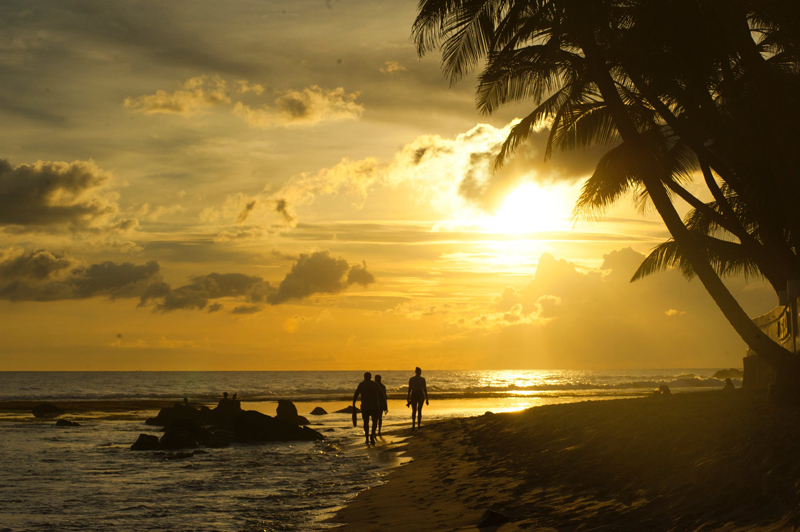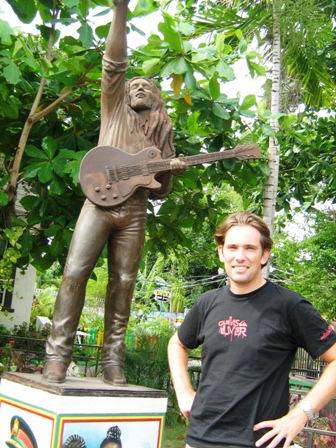10 more must see places in the Caribbean

In April 2012, a collection of UNESCO World Heritage sites, historic landmarks and natural wonders practically picked themselves for the first top 10 list of must-see places to visit in the Caribbean. The next ten are no less special, but have the cachet of being a little less known.
San Salvador
To stand in the spot where Christopher Columbus first set foot in the New World in 1492, head to San Salvador island in the Bahamas. Although other islands in the Caribbean also claim the honor, San Salvador has gone to the greatest lengths to ally itself with the event. Four monuments honor Columbus’ arrival on the island, which was formerly known as Watlings Island and is home to just over a thousand inhabitants. Part of the Bahamas Out Islands, San Salvador is also a snorkeling and reef diving Mecca with miles of powdery beaches and a large Club Med resort, thus direct flights to Montreal and Fort Lauderdale.
Haiti
Although visiting Haiti can be a fraught, potentially dangerous experience, the country was the first independent nation in the Americas, following the slave revolt of 1804. Visitors can tour the monuments and legacy from this era at the National History Park, a UNESCO Heritage Site. The ruins of the once-opulent Sans Souci palace in Milot and the nearby mountaintop Citadel, the largest fortress in the Americas, are both powerful icons from Haiti’s majestic past.
Dominica
One of the Caribbean’s most unspoilt islands, Dominica seems to surge from the Caribbean Sea into looming peaks covered with rainforest. Not surprisingly, when Bear Gryls was looking for a wilderness in which to survive for one episode of Man v Wild, he chose Dominica. The Morne Trois Pitons National Park begins a few miles outside capital Roseau and takes its name from the 1,342-meter-high volcano which dominates a surrounding landscape of waterfalls, “boiling lakes”, hot springs and rainforest.
Belize
Although the Caribbean has seen a drastic degradation of its natural coral reef systems in recent years, losing an estimated 80% through climate change and pollution, Belize’s Barrier Reef is the largest system in the Northern Hemisphere. Stretching almost 200 miles, the offshore system draws huge numbers of snorkelers and divers, particularly from the cruise ship passengers on Western Caribbean tours.
Barbuda
The twin island nation of Antigua and Barbuda claims 365 beaches as part of its tourism package. For something different, head to the untouched tranquility of Barbuda, where a pristine expanse of pink sand beach stretches 10 miles along the southwestern shore. Travel + Leisure magazine called this one of the best secret beaches on earth.
Jamaica
Dunn’s River Falls and the Blue Mountains may be the most photographed natural features in Jamaica, an island already blessed with stunning scenery, but who would want to leave the reggae island without paying homage to Bob Marley? Three sites not to be missed, and all within easy reach of each other, are the Culture Yard Museum in Trench Town, where Marley once lived and learnt his craft, the Bob Marley Museum in Kingston which was later home to the singer and Tuff Gong Records, and the Mausoleum at Nine Mile, in the mountains above Ocho Rios, where Marley was born and now rests.

Tobago
Twenty miles east of its bustling, industrial neighbor Trinidad, with which it forms a republic, Tobago is an oasis of tranquility and nature. Locals like to claim that this was the island that inspired Robinson Crusoe. There would have been few better places to be shipwrecked – acres of rainforest, reefs that enchanted Jacques Cousteau, and sleepy coastal villages where the main activity is still “limin’” with a cold Carib beer.
Grenada
Although it was annihilated by Hurricane Ivan in 2004, the so-called Spice Island, famous for its nutmeg production, bounced back and attracts a steady stream of visitors with none of the fuss and crowds of similar-sized islands. One of the most striking attractions is Grand Etang Lake, high in the mountains which run through Grenada’s spine. The lake, which lies at almost 2,000 feet, fills a volcanic crater and is surrounded by rainforest, but is reached by a road which crosses the island interior.
St. Vincent
While the surrounds islands of the Grenadines, including Bequia and Mustique, attract international jetsetters and royalty, the main island of St. Vincent has its hidden delights. Chief among them is the Botanical Gardens in Kingstown, the oldest in the Western Hemisphere and founded in 1768. Visitors can stand beneath the breadfruit tree descended from the plant brought by Captain Bligh in 1793.
St. John
American visitors to the US Virgin Islands do not even require a passport. While the big hotels and most of the action is in St. Thomas, neighboring St. John is 60 percent untouched national park. Best known is Trunk Bay, a spectacular strip of sand with an underwater snorkeling park signposted with information on coral and fish species lurking nearby. Incidentally, the other US Virgin Island of St. Croix also packs a famous beach: Sandy Point Natural Wildlife Refuge on the southwest coast was the setting of the final scene of The Shawshank Redemption.
San Salvador
To stand in the spot where Christopher Columbus first set foot in the New World in 1492, head to San Salvador island in the Bahamas. Although other islands in the Caribbean also claim the honor, San Salvador has gone to the greatest lengths to ally itself with the event. Four monuments honor Columbus’ arrival on the island, which was formerly known as Watlings Island and is home to just over a thousand inhabitants. Part of the Bahamas Out Islands, San Salvador is also a snorkeling and reef diving Mecca with miles of powdery beaches and a large Club Med resort, thus direct flights to Montreal and Fort Lauderdale.
Haiti
Although visiting Haiti can be a fraught, potentially dangerous experience, the country was the first independent nation in the Americas, following the slave revolt of 1804. Visitors can tour the monuments and legacy from this era at the National History Park, a UNESCO Heritage Site. The ruins of the once-opulent Sans Souci palace in Milot and the nearby mountaintop Citadel, the largest fortress in the Americas, are both powerful icons from Haiti’s majestic past.
Dominica
One of the Caribbean’s most unspoilt islands, Dominica seems to surge from the Caribbean Sea into looming peaks covered with rainforest. Not surprisingly, when Bear Gryls was looking for a wilderness in which to survive for one episode of Man v Wild, he chose Dominica. The Morne Trois Pitons National Park begins a few miles outside capital Roseau and takes its name from the 1,342-meter-high volcano which dominates a surrounding landscape of waterfalls, “boiling lakes”, hot springs and rainforest.
Belize
Although the Caribbean has seen a drastic degradation of its natural coral reef systems in recent years, losing an estimated 80% through climate change and pollution, Belize’s Barrier Reef is the largest system in the Northern Hemisphere. Stretching almost 200 miles, the offshore system draws huge numbers of snorkelers and divers, particularly from the cruise ship passengers on Western Caribbean tours.
Barbuda
The twin island nation of Antigua and Barbuda claims 365 beaches as part of its tourism package. For something different, head to the untouched tranquility of Barbuda, where a pristine expanse of pink sand beach stretches 10 miles along the southwestern shore. Travel + Leisure magazine called this one of the best secret beaches on earth.
Jamaica
Dunn’s River Falls and the Blue Mountains may be the most photographed natural features in Jamaica, an island already blessed with stunning scenery, but who would want to leave the reggae island without paying homage to Bob Marley? Three sites not to be missed, and all within easy reach of each other, are the Culture Yard Museum in Trench Town, where Marley once lived and learnt his craft, the Bob Marley Museum in Kingston which was later home to the singer and Tuff Gong Records, and the Mausoleum at Nine Mile, in the mountains above Ocho Rios, where Marley was born and now rests.
Tobago
Twenty miles east of its bustling, industrial neighbor Trinidad, with which it forms a republic, Tobago is an oasis of tranquility and nature. Locals like to claim that this was the island that inspired Robinson Crusoe. There would have been few better places to be shipwrecked – acres of rainforest, reefs that enchanted Jacques Cousteau, and sleepy coastal villages where the main activity is still “limin’” with a cold Carib beer.
Grenada
Although it was annihilated by Hurricane Ivan in 2004, the so-called Spice Island, famous for its nutmeg production, bounced back and attracts a steady stream of visitors with none of the fuss and crowds of similar-sized islands. One of the most striking attractions is Grand Etang Lake, high in the mountains which run through Grenada’s spine. The lake, which lies at almost 2,000 feet, fills a volcanic crater and is surrounded by rainforest, but is reached by a road which crosses the island interior.
St. Vincent
While the surrounds islands of the Grenadines, including Bequia and Mustique, attract international jetsetters and royalty, the main island of St. Vincent has its hidden delights. Chief among them is the Botanical Gardens in Kingstown, the oldest in the Western Hemisphere and founded in 1768. Visitors can stand beneath the breadfruit tree descended from the plant brought by Captain Bligh in 1793.
St. John
American visitors to the US Virgin Islands do not even require a passport. While the big hotels and most of the action is in St. Thomas, neighboring St. John is 60 percent untouched national park. Best known is Trunk Bay, a spectacular strip of sand with an underwater snorkeling park signposted with information on coral and fish species lurking nearby. Incidentally, the other US Virgin Island of St. Croix also packs a famous beach: Sandy Point Natural Wildlife Refuge on the southwest coast was the setting of the final scene of The Shawshank Redemption.

Related Articles
Editor's Picks Articles
Top Ten Articles
Previous Features
Site Map
Content copyright © 2023 by Nick Marshall. All rights reserved.
This content was written by Nick Marshall. If you wish to use this content in any manner, you need written permission. Contact Nick Marshall for details.


